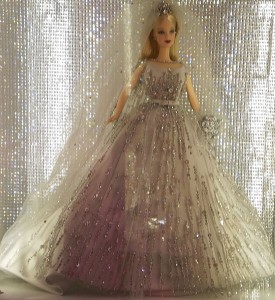barbie: a memoir and social history
It’s possible that no toy has been subjected so consistently to feminist criticisms as Mattel’s Barbie Doll.
As a kid, I heard many of them from my mother.
I heard how that ‘if Barbies were real women, they would be nine feet tall.’ ‘Look at their feet, they’re not at all like real people’s.’ ‘No one’s waist and bum and boobs end up looking like that.’ ‘If a real woman had that body, she wouldn’t be able to stand up and she would be very uncomfortable, if not in pain.’ ‘You know you’re not going to look like that when you grow up?’
Nevertheless, my sister Melanie and I wanted one. They were advertised on TV and our friends and cousins had them. They were The Thing.
They’ve been The Thing since 1959, when Mattel launched the very first Barbie Doll at the American International Toy Fair. Until Barbie, children’s dolls were all babies; they were designed to socialise little girls into motherhood. Barbie’s creator, Ruth Handler, always said her inspiration for the doll was her daughter’s fascination with dressing up and role-playing paper dolls. The paper dolls gave the little girl a space to explore other grown-up activities like socialising and working.
Barbie was created in that spirit: a grown-up avatar through which children could experiment. Over the decades she has had many careers, accessories and friends, and a few different hair styles and face moulds.
She was a powerful post-World War II symbol: an all-American girl who was simultaneously capable, sexy and fashionable – so versatile that, with a change of outfit and accessories she could move from heart surgeon to dinner date to domestic goddess, vacuuming in heels.
Melanie and I, after much nagging, were each furnished with one. Mine was called Peaches and Cream and came with a ball gown with a lustrous pearl bodice and a frothy peach skirt. Melanie’s had dark hair, and arms that moved via a switch in her back.
We loved to play with them and did use them to act out different scenarios. The stories we concocted ranged from things we had no idea about, like going on dates (with such catches as Skeletor and Hook the Decepticon), to things that were very familiar, like collecting firewood or going camping.
Barbie’s iconic blondeness has a curious history. When Ruth and her husband and business partner, Elliot Handler, took their family – daughter Barbie and son Ken – on a trip to Switzerland, Ruth noticed a doll in a window: blonde and buxom, named Lilli. She bought one and basically copied it to create Barbie.
The twist is that Lilli wasn’t for children. She was a piece of German erotica that adult men hung from their rear-view mirrors and that bars all over Germany and Switzerland displayed in the company of girlie posters and calendars.
Another twist is that her original creators, brothers Rolf and Kurt Hausser, were almost certainly Nazi sympathisers. Other dolls made by their company included Nazi stormtroopers, black-shirted figurines, members of the Nazi elite and many different Adolf Hitler toys. Barbie fits into their catalogue as the perfect Aryan woman with a good child-bearing figure.
Only she was made famous by a Jewish American woman who wanted to empower little girls by expanding their ideas of what they could grow up to be.
Like any complex woman, as an artefact, Barbie contains multitudes. She has a cartoonish body shape, is an independent woman of many careers, a mother, friend, lover, symbol of both feminine empowerment and sexism, with roots on both sides of World War II.
I tired of playing with Barbies eventually and Melanie moved onto more complex Barbie-oriented problems, like how to construct a working parachute for them.
‘I think I parachuted them successfully then moved onto mice and guinea pigs and then my kitten,’ she remembers.
‘It was the cat that was a real fizzer. I didn’t grasp the exponential increase you need in surface area of the parachute when the weight of your parachutee increases.’


